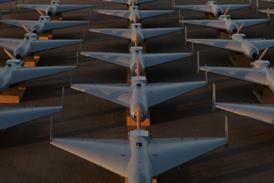Worldwide passenger and cargo totals grew in 2000, but the first effects of the US slump are being felt
Chris Jasper/LONDON
The world's airports experienced sustained growth in passenger totals and cargo tonnage last year - both up by 6% on 1999 - yet figures for December suggest that by then the sector was beginning to feel the effects of the US economic slowdown. A general decline in aircraft movements during 2000, again most pronounced in the USA, reinforces the impression that not everything in the garden is rosy.
Full-year figures published by Airports Council International show that passenger numbers at the 660 airports surveyed increased by an average of 5.8% and cargo tonnage by the same degree. Both figures are impressive, given that they represent an improvement on 1999, which itself produced strong growth as airports bounced back from the Asian financial collapse.
The Asia-Pacific, which rebounded hardest in 1999, again led the way with the biggest rise in passengers (8.2%) and the only double-digit increase in cargo (11%, after a 13% rise the previous year). All regions followed suit to varying degrees. Latin America again posted the smallest rise in passenger numbers (up 1.9%) but enjoyed a surge in freight (up 6.2%) after a flat 1999. Growth in the Middle East last year was in line with 1999, but Africa saw passenger growth slow while cargo growth quickened.
Most marked, however, was the contrasting performance of airports in the two biggest markets: Europe and North America (together accounting for 75% of passengers). While in North America, the most mature of markets, passenger numbers grew by a modest 3.9% (as in 1999) and cargo by just 2.3% (the lowest regional total), Europe enjoyed an improvement of 7.9% in both sectors, aided by double-digit growth at some of its biggest airports.
In terms of piling on the passengers, Madrid (up 18%) and Paris Charles de Gaulle (CDG - up 11.6%) led the way, the latter boosted by a new terminal dedicated to fast-expanding Air France, which also launched the SkyTeam alliance. In Asia, Hong Kong's airport at Chek Lap Kok saw passenger growth of over 10% in its second full year of operation, as did Seoul Kimpo, which becomes a domestic terminal now that Incheon International is open.
In the USA, Atlanta Hartsfield and Chicago O'Hare remain the world's busiest airports, but passenger growth at the former slowed to 2.8%, and O'Hare saw numbers fall. International passenger traffic continued to be dominated by Europe's 'big four': London Heathrow (59.6 million), CDG (43.6 million), Frankfurt (40.4 million) and Amsterdam (39.1 million). Yet congested Heathrow saw the slowest overall passenger growth outside the US, at 3.8%.
In the cargo market, the same names were evident among the fastest growers. Hong Kong, second busiest after FedEx-hub Memphis, grew by 13.3%, CDG by 14.5% and Seoul by 13.2%, although all three lagged behind Taipei (14%) Osaka (15.8%) and Dubai (18.6%), which rode the Asian cargo boom.
In contrast, five major US airports saw cargo traffic fall, led by Dayton (down 7%) and O'Hare (down 4.6%). Movements also fell in the USA, with Santa Ana (-17.8%), Oakland (-14.3%) and Los Angeles (-7.8%) suffering most. All are in California, worst hit by the US slowdown due to its reliance on technology companies. Globally, aircraft movements inched up by just 1% - although when combined with growth in passengers and cargo such a trend is not necessarily negative, and can point to improved aircraft utilisation.
December figures revealed the beginnings of the slump which saw US carriers suffer first quarter losses. Worldwide, passenger traffic rose 6%, but cargo and movements were down 4% and 3%. The Asia/Pacific, Latin America and Europe saw passenger numbers grow by around 10%, but North American airports trailed on 2% - and in cargo and movements their decline was more pronounced, down "dramatically" by 8% says ACI, "in line with the slowdown in the US".
Source: Flight International























